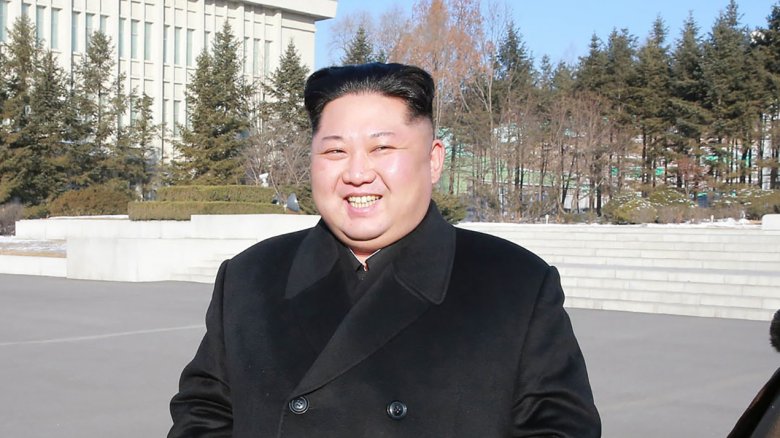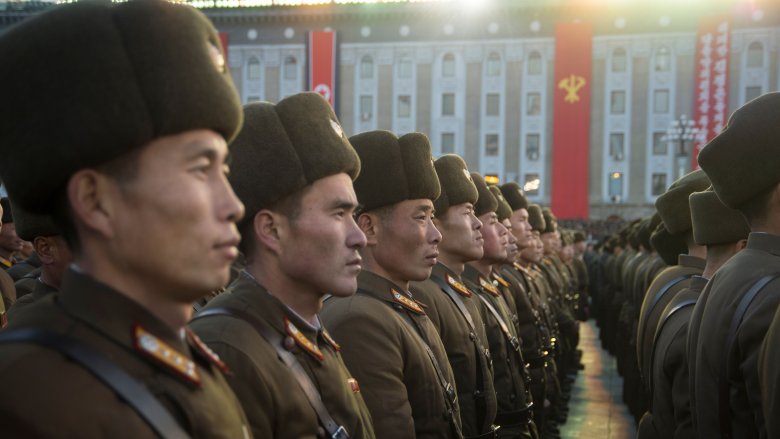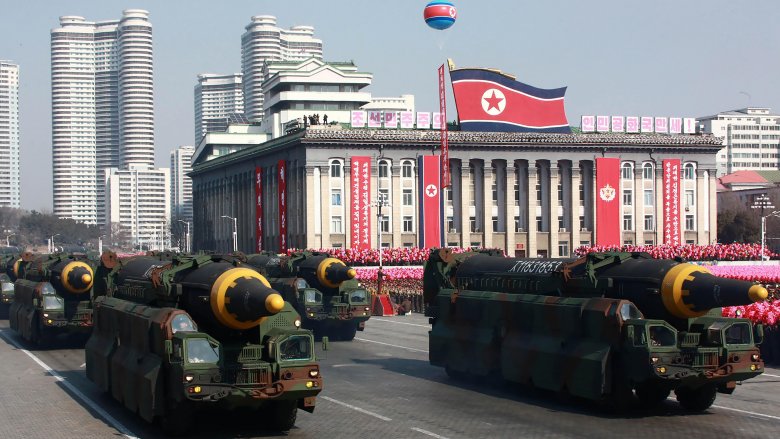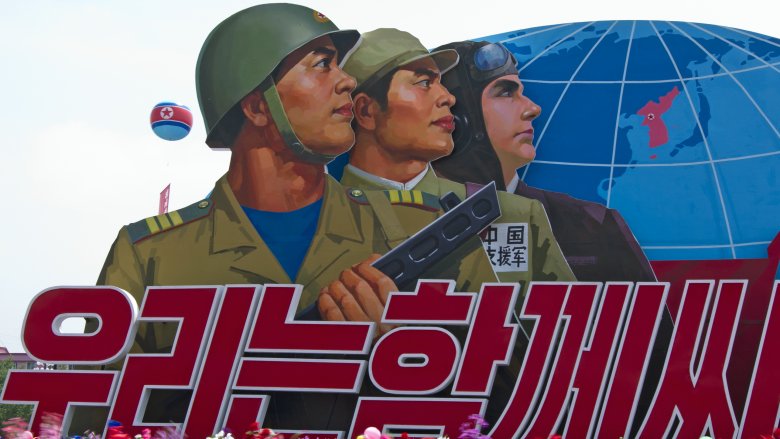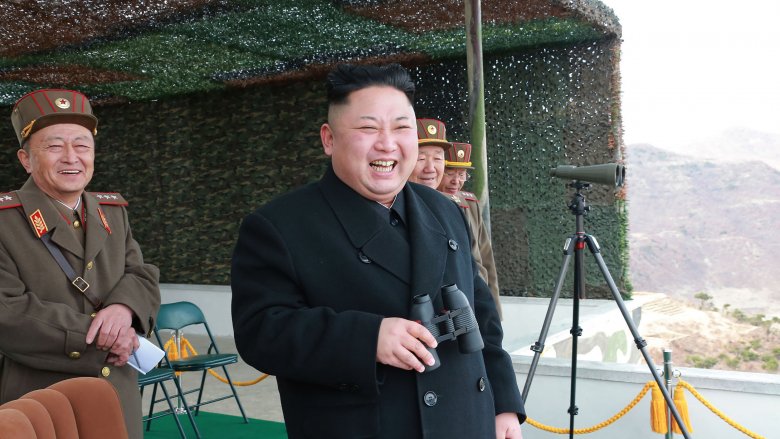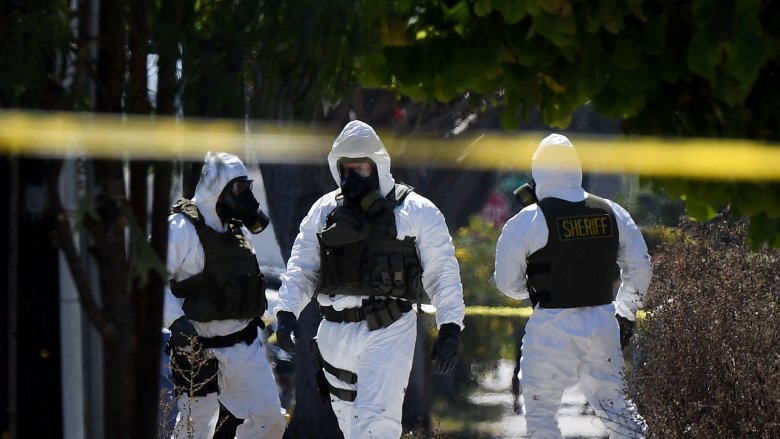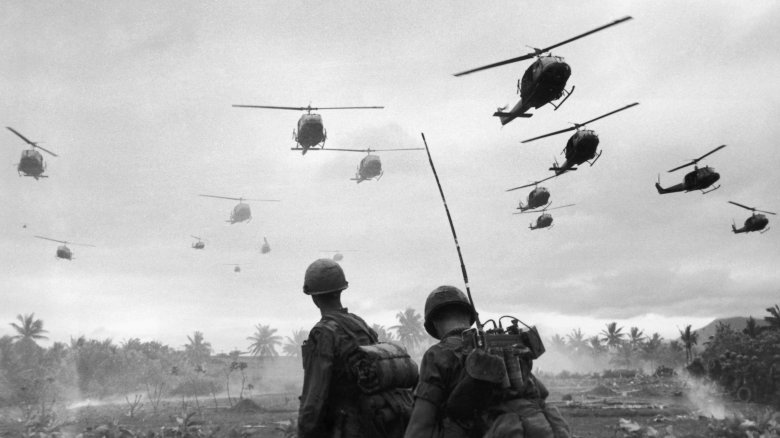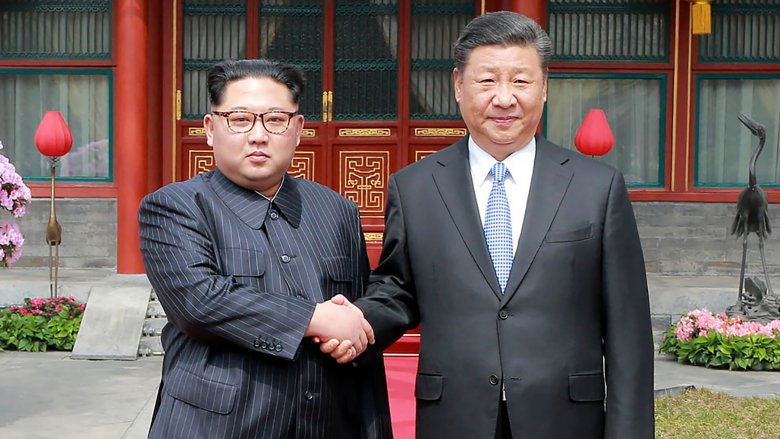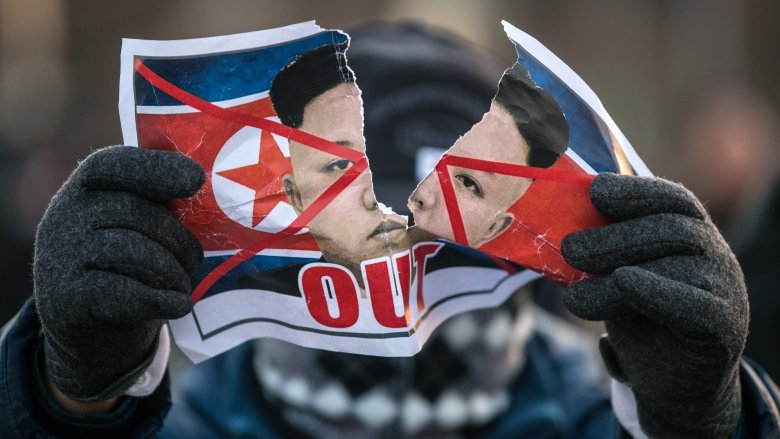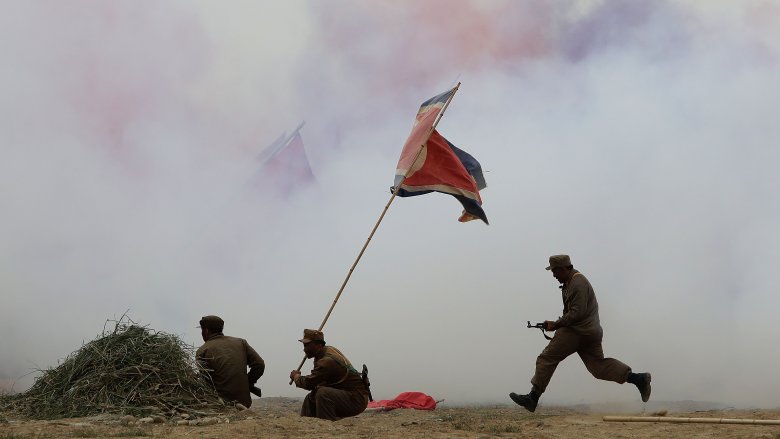What War With North Korea Would Actually Look Like
North Korea is the geopolitical equivalent of the drunken uncle at a wedding. Everybody would really, really like it if they'd just put down the wine/fissile plutonium and leave, but everyone also knows that trying to kick them out would result in the nuclear obliteration of the entire Korean peninsula. Under pudgy dynastic tyrant Kim Jong-un, North Korea (also known by the presumably ironic name Democratic People's Republic of Korea, or DPRK) has repeatedly flouted international norms, threatened the world with destruction, and generally acted like a half-cut bully. All it needs to do now is drunkenly make a pass at its own niece and our wedding analogy is basically complete.
But what would happen if someone did the unthinkable, and actually tried to eject boorish Uncle Kim? In other words, what if developed nations really did take the fight to North Korea? Well, there's good news and there's bad news. The good news is North Korea would almost certainly lose. The bad news is the path to that defeat would make the invasion of Iraq look like a cakewalk.
It starts with an accident
Going to war with a nuclear state is such a huge decision that you probably hope it'd be just that: a decision, one not taken lightly. If that's the case, you'd better skip ahead. According to Politico, many U.S. military planners believe a new war on the Korean peninsula has a good chance of being triggered by accident.
North and South Korea have a history of upsetting one another. The DPRK has previously shot down U.S. helicopters, South Korean troops have accidentally wandered into the demilitarized zone (DMZ), and soldiers have exchanged gunfire at the border. When tensions are cool, these incidents are diplomatic spats. When tensions are already boiling, they're like going up to a sleeping lion and repeatedly kicking it in the babymaker.
The trigger could be the tiniest thing. Asia-Pacific specialist Michael Mazarr told Politico that North Korea could launch a missile test that malfunctions and flies toward Japan in a way that looks like an attack. Others suggested the U.S. could launch a limited "bloody nose" strike, as when 59 Tomahawk missiles slammed into a Syrian airbase in April 2017, only to have Kim assume it's the opening salvo in a full-blown war. It's what Hardcore History's Dan Carlin, in reference to the outbreak of World War I, called starting the doomsday device: the beginning of an unstoppable chain of events where each side thinks they've no choice but to escalate or face annihilation. It just takes one overreaction to set the whole thing going.
War Route 1: Missiles start flying
If you want nightmares, read this article by Foreign Policy. Written by the director of the East Asian Nonproliferation Program, Jeffrey Lewis, it lays out evidence for Pyongyang using nuclear weapons in the event of war. Since Kim Jong-un came to power, North Korean forces have been testing missiles all over the country, demonstrating that they could hit Japan and South Korea. Lewis says this shows the DPRK's war plan likely revolves around an early nuclear strike. Pretty scary if he's right.
Kim's super weapons are "use it or lose it" toys. In the event of war, invading forces would immediately target Pyongyang's nukes. That means Kim has to fire them at the very start of a conflict or else probably not fire them at all. Here's where it gets pants-wettingly terrifying. In a separate article for Washington Post, Lewis writes that the North's game plan is probably to gamble on a quick, massive nuclear strike being so shocking that it keeps the U.S. out of any conflict. That means every warhead the DPRK has going (a minimum of 25) being flung at South Korea and Japan.
The U.S.-Korea Institute at Johns Hopkins ran the numbers. Their low-end estimate assumed only 20 percent of Pyongyang's nukes would actually detonate, and each would have a low yield of only 15 kilotons. They concluded this would be enough to kill 400,000 in Seoul and Tokyo alone.
War Route 2: North invades South
No one can say exactly what a cornered Kim Jong-un would do. That might be why The Diplomat war-gamed a conflict on the peninsula that didn't involve nukes at all. Assuming Pyongyang might want to deliberately keep nuclear weapons out of the conflict, they tried to calculate what would happen if the North just straight invaded the South. In its own way, it was almost as scary as the thought of nuclear war.
North Korea has over 500 artillery weapons permanently trained on South Korea's capital, Seoul. The greater Seoul area has around 25 million people living in it. If Kim decided his best chance for survival was a ground invasion across the DMZ, he'd begin by shelling the city. That would mean a rain of fire battering down on this one megacity, blowing buildings apart, destroying streets, and causing more chaos than a Godzilla-Clover royal rumble. By the time U.S. and South Korean forces scrambled to take out Pyongyang's batteries, tens of thousands could be dead.
Speaking of U.S. and South Korean forces, there's a good reason Pyongyang might want to kill 10,000 civilians. Survivors in Seoul would flee, clogging up roads that counterattack forces would use, thus buying Pyongyang more time. Don't assume this is a scenario that Kim wins, though. As the North's million-plus troops marched through the mountains, South Korean forces would start bombing them. The Diplomat estimates 100,000 DPRK troops would be killed before they could even reach Seoul.
Confusion and dirty tactics
You'll probably have a hard time believing this, but experts think Kim might not exactly play fair at war. He seems like the kind of guy you don't want to beat at Monopoly because he'll probably have you executed right there at family Christmas. He's the exact sort of person who might favor extremely dirty tactics on the battlefield. The Diplomat suggests this would probably manifest itself in a desire to create as much confusion in the invasion as possible.
Remember when Russia annexed Crimea from Ukraine in 2014? The snatching of that slice of territory was accompanied by the appearance of "little green men," Russian soldiers wearing no insignia who did Putin's dirty work in a way that could easily be denied (via Brookings Institute). In an annexation of Seoul, the North's Korean People's Army (KPA) would likely go even further. The Diplomat suggests their Special Operations Forces would infiltrate the South ahead of an invasion, don South Korean uniforms on invasion day, and create chaos.
The goal would be to leave the conflict in a fog of confusion, one made even worse by crippling cyberattacks launched against South Korean infrastructure. As the New York Times explains, North Korean cyberattacks are no longer just the punchline to lazy jokes, but an actual, as-scary-as-the-clown-in-It threat. They could keep both Seoul and Washington on the back foot until the North has captured whole districts of the southern capital.
WMDs and terror attacks
If you were a gambler, you wouldn't put money on the North winning this conflict. The South Korean army is so far advanced that comparing it to the KPA is like comparing a well-oiled machine to a clockwork toy drunkenly assembled by Herman Munster. The U.S. military is a whole extra warp leap ahead. That leaves Kim trying to level a near-vertical playing field. Unfortunately, Pyongyang's metaphorical earth mover is the one marked "chemical weapons."
The nonprofit Nuclear Threat Initiative estimates North Korea has the world's third-largest stockpile of chemical weapons. We know they work because Pyongyang assassinated Kim's half brother, Kim Soo Hyun, with the nerve agent VX in 2017 (via NBC). In interviews with a dozen experts, a Vox reporter found broad belief that these weapons would be deployed in a conflict. Stuff like sarin would likely be dropped onto U.S. airfields in the region in an attempt to cripple them. One expert theorized Kim might even drop his entire sarin stockpile onto Seoul itself. The Bulletin of the Atomic Scientists estimates this could kill up to 2.5 million.
If that sounds scary, it gets scarier. We've established Pyongyang would try to cause panic in the South. One way of doing that would be to unleash a biological agent like anthrax in downtown Seoul. All it would take would be a single drone or a single DPRK agent with a backpack, and you'd see mass deaths and blind panic on a whole new scale.
The U.S. enters its biggest war in decades
Looming in the background through all this is one undeniable fact. At some point, Uncle Sam is gonna come knocking on Kim's door, and that's gonna go about as well for the chubby despot as getting into a bareknuckle boxing match with a full-grown grizzly. Assuming Washington holds back on the nukes, the DPRK would find itself on the receiving end of a joint South Korean and American invading force. As Vox details, this would require the U.S. to enter its biggest armed conflict since Vietnam.
At the height of the war in Iraq, the U.S. had 166,300 troops stationed in the country. By contrast, the lowest estimate for the number of troops required in an invasion of North Korea is 200,000, according to the RAND Corporation. South Korea's official estimate is that Washington would have to commit 690,000 soldiers to the conflict. The Pentagon thinks 2,000 war planes would be required. The last time a U.S. conflict came close to these numbers, Richard Nixon was in the White House.
Such a conflict would bring a lot of U.S. casualties. In 1994, a Pentagon assessment concluded over 52,000 U.S. personnel would be killed or wounded in the first three months of a second Korean War (via The Guardian). Today, with North Korean nukes and WMDs to factor in, the U.S. casualty toll would probably be higher.
The China factor
Here's a question that keeps Pentagon war planners up at night: What would China do? Beijing is Pyongyang's closest thing to a friend. In the event of a ground invasion of the DPRK, U.S. bombers trying to take out Kim's nuclear stockpiles would be required to fly right up to the Chinese border, a prospect as comfortable for Beijing as armed Chinese bombers skimming the edges of Niagara Falls would be for Washington. The New Yorker attempted to sum up the potential Chinese reactions to war on the peninsula. They ranged from "China does nothing" to "whoops, here's World War III."
The idea of China going to war with the U.S. to help North Korea is scary, but it could be the stuff of paranoid fiction. A more likely prospect was outlined by China expert Oriana Skylar Mastro in Foreign Affairs (quoted here in Vox). She explained Beijing is deeply unhappy with the Hermit Kingdom and even less happy about the prospect of nuclear war. Rather than siding with Kim, she suggests the Chinese military would respond by invading North Korea, securing its nukes, and killing Kim.
This is where things get dangerous. Chinese troops would reach the North's WMD stockpiles first as they're close to the Chinese border. So what happens when U.S. troops show up, having fought their way through the country, only to find Beijing has nabbed the prize? Depending how selfish people are feeling, we might be right back at "here's World War III" all over again.
The Kim regime goes down in flames
Major spoiler alert! North Korea loses this war. No matter how anything we've discussed above goes down, the end result is still the Kim regime falling to pieces. While some, such as the guys at The Diplomat, believe Kim could possibly force a stalemate and cling on, the vast majority of experts predict his annihilation. In which case, the question is how long can he cling on for?
There's a lot of disagreement on this issue. The experts quoted by Vox start by saying it could take six weeks for the Pentagon just to get the necessary troops it needs into South Korea. (The 28,500 already stationed there wouldn't be nearly enough.) If the DPRK destroys South Korea's main port city, Busan, it would take even longer. You can add to that the additional six weeks Professor Robert E. Kelly told Quartz would be needed to actually win the war, or the two-plus months the International Institute for Strategic Studies estimates is necessary. Incidentally, there's no chance of getting the troops ready beforehand. In 2002, Kim's father watched as Saddam Hussein allowed U.S. forces to mass on his borders. Pyongyang won't make Baghdad's mistake.
You could argue the Pentagon may not need six weeks. Both the U.S. and South Korea have been training for years for a "decapitation strike" that would kill Kim as quickly as possible. Unfortunately, there's a lot of doubt over whether it would work, or even if it could work.
Everyone gets sucked into the quagmire
Mark Fitzgerald is the executive director of the International Institute for Strategic Studies office in Washington. In September 2017, The New Yorker asked him what the aftermath of a second Korean War would look like. Fitzgerald's prognosis was negative, to say the least. North Koreans are brainwashed from birth to believe their leader is a literal God. There's a reason plenty of cults culminate in mass suicide (see: Waco, Jonestown), and North Korea may be the biggest cult in history.
After Kim falls, we could see the type of violence on the Korean peninsula that we got in the Middle East. The New Yorker article raised the specter of surviving Kim loyalists dividing into cells and launching an insurgency like those that still plague Iraq and Afghanistan. If you needed a gruesome reminder, the Iraq Body Count database carries a current total of between 181,000 and 203,000 killed by terrorism and insurgent violence in post-invasion Iraq. There's little reason to think a post-war North Korea couldn't be equally fanatical and violent.
It wouldn't just be Koreans who suffered (although they'd obviously bear the brunt of it). A post-war civil meltdown could bog down the U.S. in the region for years or even decades. If China also gets involved, the geopolitical power games could create a quagmire none can escape from. It's kinda hard to imagine any U.S. president declaring "mission accomplished" and handing everything over to Beijing.
The global economic shock sets in
One thing all predictions about a Korean conflict have in common is their unanimous belief that Seoul will be obliterated. This is actually even worse than you probably think it is. The greater Seoul area and surrounding provinces are home to over half of South Korea's 51.25 million residents. According to the OECD the region generates nearly a quarter of the country's GDP, rising to over 40 percent if you include nearby Gyeonggi. This is significant because a 50 percent drop in South Korea's GDP would be enough to damage the global economy (via Foreign Policy in Focus).
South Korea is one of the "Asian tigers" driving the engine of global growth. Upending South Korea's economy — in an apocalyptic war, say — would knock a whole percent off global GDP and severely mess up the economies of its trading partners like China and Japan. That's the same China and Japan that are the second- and third-biggest economies on Earth, respectively, and may also be devastated by DPRK missiles.
War costs aside, there's the matter of reconstruction and eventual Korean reunification. The costs of putting both Koreas and maybe Japan back together again would leave all the king's horses and all the king's men weeping over their empty wallets. Without a major war, reunifying East and West Germany cost $2 trillion over 20 years. The estimated costs for reunifying Korea? Three trillion dollars, according to the Independent. Talk may be cheap, but war is terrifyingly expensive.
